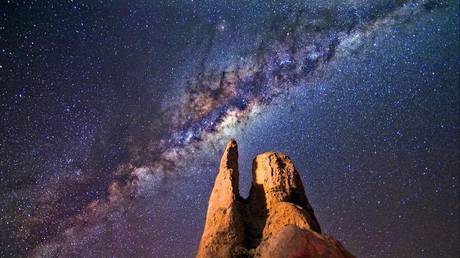
Astronomers have discovered a surprisingly orderly, almost copy of our Milky Way galaxy 12.4 billion light-years away which may upend our current theories about galactic formation and evolution.
Our galactic almost-twin is called SPT0418-47 (not quite as catchy as the Milky Way), and is a flat, rotating disc with a similar mass to our own galaxy, though it wasn’t blessed with spiralling arms.
It is the earliest galaxy yet discovered with a so-called ‘galactic bulge,’ a tightly packed group of stars at its core, which apparently formed when the universe was just 1.4 billion years old.
What’s more, we might never have spotted it, were it not for some cutting-edge tech combined with pioneering computer modeling techniques, along with a large dose of good fortune.
Our current generation of extremely powerful telescopes has allowed us to peer farther in time and space than ever before but it was actually a fortuitous “introduction” by a third galaxy, located between us and SPT0418-47, that allowed us to see our galactic doppelganger.
This third galaxy created what is known as a gravitational lens, where space time is bent around a massive object, creating a magnified, if somewhat distorted, ring-shaped projection of SPT0418-47 which was spotted by astronomers using the the Atacama Large Millimeter/submillimeter Array in Chile.
This projection was then analyzed and painstakingly reconstructed using advanced computer modeling techniques to reveal the most Milky Way-like galaxy ever found, but formed during the first 10 percent of the universe’s life, and therefore forcing a rethink of our current understanding.
“What we found was quite puzzling; despite forming stars at a high rate, and therefore being the site of highly energetic processes, SPT0418-47 is the most well-ordered galaxy disc ever observed in the early Universe,” said astrophysicist Simona Vegetti of the Max Planck Institute for Astrophysics.
The discovery forces us to reshape our understanding of how galaxies both form and evolve, which didn’t take as long as we thought as it turns out.
“This result represents a breakthrough in the field of galaxy formation, showing that the structures that we observe in nearby spiral galaxies and in our Milky Way were already in place 12 billion years ago,” said astrophysicist Francesca Rizzo of the Max Planck Institute for Astrophysics in Germany.
Think your friends would be interested? Share this story!




